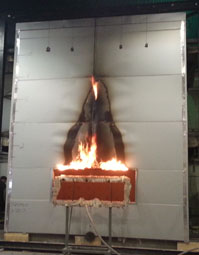Importance of Using Tested ACM Systems
April 25, 2016

What is testing?
- Testing is the process used to compare a product (in this case an ACM panel system) to an industry established benchmark for a given set of performance criteria
- In general terms, testing is used as a measure of quality and performance
What is the purpose of testing?
- Quality assurance – verify the performance of the product to maintain customer satisfaction
- Risk management – check for the existence of defects or errors
- Optimization – identify cost savings through product optimization
- Innovation – become a leader in your market/industry through development of new products and systems
- Competitive advantage – achieve product superiority over competitors
What are the steps to conducting testing?
- Inspection
- Evaluation through visual examination to identify a testing need
- Demonstration
- Measuring and recording qualitative and quantitative data from real and/or simulated conditions
- Analysis
- Evaluation of measured and recorded data using mathematical representations, graphs, or calculations
- Conclusions
- Benchmark of product quality and performance through comparison to gathered analytical data
Why is standardized testing important?
- Anyone can perform a test on a product and achieve results
- When products are tested against a standardized industry benchmark, it allows for an objective comparison to all other similar tested products within an industry
- Standardized testing allows for the development of specific performance requirements related to construction types and regional regulations
What standardized testing performance requirements are commonly referenced in the ACM and wall assembly world?
- National Fire Protection Agency (NFPA) 285
- For testing non-combustible wall assemblies, the International Building Code (IBC) references the National Fire Protection Association (NFPA) standard 285, “Standard Fire Test Method for Evaluation of Fire Propagation Characteristics of Exterior Non-Load-Bearing Wall Assemblies Containing Combustible Components”
- NFPA 285 provides a standardized fire test procedure for evaluating the suitability of exterior, non-load bearing wall assemblies used as combustible components for installation on buildings where the exterior walls are required to be non-combustible
- Its successful completion demonstrates the ability of an exterior ACM panel system to limit vertical and horizontal flame spread across the face and through the core
- Miami-Dade NOA and Florida Product Approval
- Florida is one of the most hurricane-prone regions in the continental United States and as such is subject to stringent performance requirements related to high-velocity hurricane zones
- Miami-Dade Notice of Acceptance (NOA) and Florida Product Approvals are regulatory certifications that require a product be subjected to specific testing protocols to demonstrate suitability for installation in high-velocity hurricane zones
- While a Miami-Dade NOA or Florida Product Approval are mandatory on construction projects in the state of Florida, many other coastal areas have adopted or reference these requirements
- ACM panel systems with these certifications often have specialized installation requirements beyond what is required for a standard installation
- Obtaining these regulatory certifications provides a quality benchmark for an ACM panel system by demonstrating its ability to withstand the most severe wind loads
Why are tested products and systems important?
- The performance of ACM panel systems installed as building veneers during fire and severe weather events could be the factor that minimizes property damage and saves lives
- Standardized testing and associated performance criteria ensure that consumers understand the variety of products available, which are appropriate for their specific needs/requirements, and which will provide the best value
What does this all mean for you?
- Not every product is appropriate for your application
- Specifiers must be aware of additional performance requirements related to construction type and regional regulations that may limit the compliance of certain ACM panel systems under specific conditions
- External testing requirements provide a benchmark that can be used as a means for objective comparison of both quality and performance between ACM panel systems in today’s market